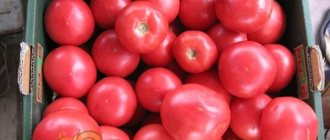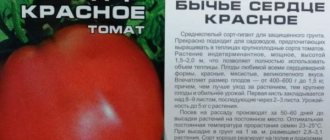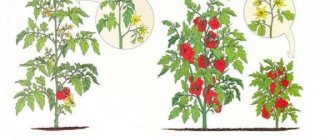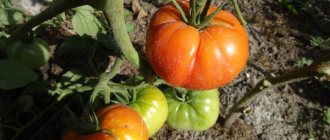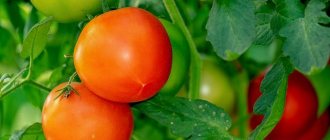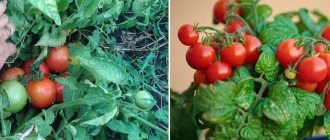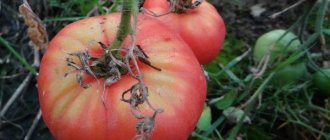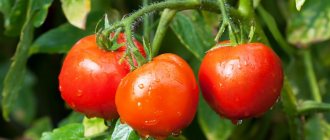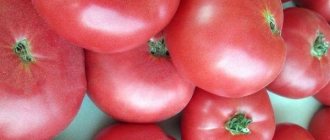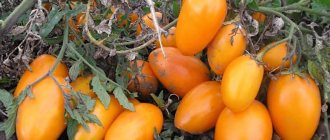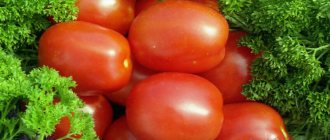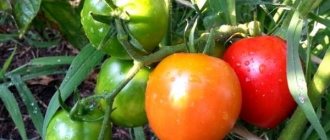Super early harvest ripening
Abundant fruiting and early fruit ripening are the main advantages of super-early tomato varieties.
Typically, these include plants whose harvest ripens in 90 - 100 days.
Among the hybrids and new varieties bred by breeders in recent decades, there are ultra-early varieties of tomatoes, the ripening of fruits and harvesting of which begins on the 70th day.
For growing in greenhouses
The most popular tomato varieties for greenhouses are:
- Mandarin duck - produces a harvest within 90 days, fruit weight is 90 - 100 g, the shade is bright orange. Tomatoes are collected in clusters of 10 pieces.
- Greenhouse early ripening F1 is a hybrid with fruit ripening within 85 days. One tomato weighs 120 - 180 g, they have a round shape and a bright red color.
- Present F1 is a popular variety with fruits weighing up to 170 g, round in shape, which are distinguished by the possibility of long-term storage.
- Raspberry sugar plum - ripens within 87 days, the tomatoes are small, only 20 - 25 g each, elongated, very sweet and tolerate transportation well.
- Superstar - the ripening period of the variety is 85 days, the tomatoes are very large - they weigh up to 200 g, they are round and red, they perfectly complement any salads.
- Meal - a variety with small tomatoes weighing only 20 g each, they are oval in shape and store well.
List of super early tomato varieties
You will find more detailed information on each variety in our articles.
For your convenience, we have compiled a table of super early tomato varieties in alphabetical order:
| Aurora F1 | Alenka | Alpha | Anyuta F1 |
| Aphrodite F1 | White filling | Big Mama | Boni M |
| Debut | Mystery | Pickling miracle | Golden stream |
| Katyusha | Room surprise | Labrador | Leopold |
| Locomotive | Lyana Pink | Moscow Stars F1 | Pink Impression |
| President 2 | Sanka | Severenok F1 | Bullfinch |
| Solerosso F1 | Ultra early ripening F1 | The Lazy Man's Miracle | Shchelkovsky early |
Determinate or indeterminate
- Determinant These are plants whose main stem stops growing after the first 4-5 clusters have set.
Determinate varieties are grown both in open ground and in greenhouses.Removal of stepsons is carried out at will, to obtain a more friendly harvest. In areas with a cold climate and short summers, super-early determinate varieties of tomatoes are recommended to be grown in protected soil.
There are a large number of varieties of determinate super-early ripening, super-early tomatoes. This is due to the fact that low-growing plants spend less energy on the growth of stems, branches, and leaves, and spend more energy on setting fruits and ripening the crop.
- Indeterminate varieties continue to grow throughout the life of the plant.
They require mandatory tying of stems and pinching. More often, indeterminate varieties are grown in greenhouses. In regions with warm climates, they grow well in open ground on a trellis. Prominent representatives of indeterminate early ripening tomatoes are raceme and Cherry varieties - “Kira” F1, “Samara” F1, “Forte Mare” F1, “Grozdevoy” F1 and many others.
Hybrid or variety
Every gardener has at least once wondered what the differences are between hybrid and simple tomatoes and how to choose the right one for your plot. First you should know the advantages and disadvantages of each type.
Advantages of varieties:
- constant characteristics;
- the possibility of obtaining seeds yourself;
- low price for seeds.
Disadvantages of varieties:
- less resistant to diseases compared to hybrids;
- the harvest volume is significantly less.
Advantages of hybrids:
- high yield rates;
- simultaneous fruiting;
- long-term preservation of presentation;
- immunity to many diseases.
Disadvantages of hybrids:
- high cost of seeds;
- impossibility of independently obtaining seeds.
To grow ultra-early tomatoes just for yourself, you can buy seeds of regular varieties. It is easier to care for a small area of plantings, protecting tomatoes from pests and diseases. But when planting for sale, it is better to give preference to hybrid varieties, because the amount from their sales will quickly pay for all the costs of the seeds.
Timing of sowing seeds and care features
Attention! High-quality seedlings of super-early tomato varieties have a thickened stem, short internodes, 6-8 leaves and at least one or two flower clusters.
To grow such seedlings, you need to correctly calculate the time for sowing the seeds.
- Growing tomatoes indoors. If the seedlings are planned to be planted in a greenhouse before June 10, then the seeds must be sown on March 18-20. For correct calculation, we take into account the time of germination - 5-8 days, the beginning of flowering - 55-60 days, adaptation after picking plants - 5-7 days. Seedlings are sown in boxes or two seeds are planted in separate cups. Seeds are planted in cups a week later.
- If you plan to grow tomatoes in open ground , seedlings are planted in a permanent place later, taking into account a possible drop in night temperatures. Therefore, the seeds are sown in early April.
Sowing seeds and caring for seedlings:
- Seeds are sown in the ground to a depth of 1.5 cm, dry or pre-soaked in water for swelling. Soaking time is no more than 24 hours.
- The crops are covered with film or glass.
- Seed germination temperature - + 25 degrees.
- For better seedling yield, after the first “hooks” appear, additional lighting is provided for at least 14 hours. Daytime temperatures are reduced to +20, nighttime temperatures to +16.
- Water the seedlings moderately, twice a week.
- Picking is carried out when two true leaves appear. Seedlings are planted in separate containers.
- 15 days before planting the seedlings, the plants are hardened off: the air temperature is lowered by 4-5 degrees, and taken out into the fresh air.
Before sowing, it is necessary to check tomato seeds for germination. This can be done by visually inspecting the seeds or using a saline solution. Dilute salt (1 tsp) in 150 ml of water. Pour the seeds into the solution and let sit for 10 minutes. After this, mix well and remove the floating seeds - they will not sprout. Collect the seeds that have sunk to the bottom and rinse well under running water. Then leave them to swell. Check the seeds before planting.
Plant care
Without proper care of young plants, there is no point in dreaming of a good harvest. Only timely watering, pinching, and the presence of the required amount of light and heat will help achieve the desired results.
Creating a microclimate in a greenhouse
Depending on the growth phase, the temperature in the greenhouse should be different. So, during the flowering period, plants feel comfortable at 20-22 ° C in sunny weather, in cloudy weather they need 19-20 ° C, and at night even less - 16-17 ° C. When pouring fruits, the temperature should be increased - during the day to 24-26°, at night - up to 17-18°.
An increase in night temperature even by a couple of degrees can affect:
- elongation of hands,
- weakness of the stalks,
- bad ovary
- poor quality of fruits.
You can reduce the temperature by using open vents and greenhouse doors. Unlike, for example, cucumbers, tomatoes are not afraid of through air flows.
Also, the final result in growing tomatoes is affected by lighting in the greenhouse. There should be a lot of light, since its lack entails improper formation and development of plants. The foliage and stems begin to fade, the buds fall off, and the harvest turns out to be meager. Additional light sources are often installed in greenhouses.
There are varieties of tomatoes that cannot tolerate direct sunlight. In this case, it is necessary to create diffuse lighting.
Ventilation
Ventilation of the greenhouse must be done regularly. The procedure helps maintain the required level of importance indoors, which in excess can be detrimental to young tomatoes. Ventilation also helps to cope with excess heat - too high a temperature in a greenhouse is the key to curling leaves, small ovaries and dry soil.
You can ventilate the greenhouse using vents or open doors. In warm weather, you can leave the greenhouse open for the entire daylight hours; in cloudy or cool weather, a couple of hours is enough.
Tying and pinching
To obtain an early and abundant harvest, tomatoes are pinched - cutting off the side stems. A plant that does not waste nutrients on excess greenery will direct its energy to the development of useful leaves and fruits. Stepsons begin when the stems reach a length of 3-5 cm. If for some reason the stepsons were not removed at this age and grew into full-fledged stems, it is not recommended to remove them.
Firstly, the plant has already spent a lot of effort on their development, and, secondly, the breakage of large stepsons often leaves serious damage on the trunk. Stepchildren on greenhouse tomatoes are cut off once every 10-12 days (preferably in the morning), pulling the stem down until it breaks. You should not feel sorry for stepsons with the presence of an ovary - they will not produce large fruits.
Determinate plants with one stem and many inflorescences are planted like this: a few inflorescences are left on one stem, the rest is removed. After you have reached the last inflorescence, you need to save a couple of leaves and pinch the growing point. This way all the fruits will have time to ripen. In addition to the stems, you can also tear off unnecessary lower leaves.
In addition to pinching, tomato plants need staking for a successful harvest. This is especially true for tall varieties, which, when pouring fruit, can easily break under their weight.
Tying is also necessary if the lower branches have sank to the ground and the fruits have to ripen while lying on the ground. In this case, they can become easy prey for garden pests, such as slugs, or be affected by late blight.
For tying use:
- stakes,
- sticks,
- metal rods,
- plastic pipes,
- rebar scraps,
- strong twine,
- picket fence, etc.
You also need the dressing material itself - soft, without sharp edges. In this case, wire, thin rope, fishing line, or harsh thread are not suitable - they can cut into the growing stem and injure it. The best option is fabric cut into shreds 3-4 cm wide, women's nylon tights or knee socks.
Currently, special plastic garters can be purchased in stores - they are suitable both for fixing stems and supporting clusters with heavy fruits.
When growing a large number of plants, it is convenient to use a special tool - a garter. It acts like a stapler - it wraps a special tape around the support and stem of the tomato.
Features of early ripening tomato varieties
Are there any distinctive features of super early varieties? Yes, I have.
- Disease resistance. The most common and unpleasant disease of tomatoes is late blight. The cause of the disease is fungal spores. Late blight develops during a period of increasing difference between day and night temperatures and increasing air humidity. By the beginning of autumn, when weather changes occur, super-early tomatoes have time to ripen. Many varieties, especially hybrids, have stable immunity to fungal and viral diseases.
- Stem size . It is mistakenly believed that super early varieties have small stems. They can be of different sizes. The low-growing tomato “Explosion” grows to only 45 cm, and “Blagovest” F1 has a trunk length of more than 2.5 meters.
- Fruit quality. Different varieties of tomatoes differ in taste. Tomatoes are heat-loving plants. Super early tomatoes ripen in the sunniest, warmest months. Their fruits are sweet and aromatic and are mainly used for salads, making juice, and tomato paste. The taste of the juice made from them is much higher. Tomatoes are stored for a long time and do not lose their presentation during transportation.
- Fruit sizes . Super early tomatoes are not gigantic in size, but there are record holders among them. The fruits of the “Big Momma” tomato reach a weight of 400 grams. But this is rather an exception. Mostly they weigh from 100 to 200 grams, small-fruited ones - 50-75 grams.
- Productivity . All super early tomato varieties have high yields. From plants planted per 1 sq.m. harvest from 7 to 15 kg or more.
Review of ultra-early varieties
The insatiable desire to collect early tomatoes after 2-2.5 months encourages vegetable growers to plant ultra-early varieties on their plots. In the garden, the crop produces a harvest already in July, and in the greenhouse even earlier. For summer residents engaged in commerce, this is a good option to make money on early vegetables. The presented photo and description of tomatoes will allow summer residents to choose the varieties that best suit their needs.
King of the Early
This tomato variety allows you to harvest in 3 months. The vegetable is considered technically ripe in July. The fruit weighs 140 g. As for yield, 1 plant can produce a little more than 4 kg of tomatoes. The crop is very susceptible to damage by pathogens, so careful care must begin with the seedlings. The first thing required is hardening. The lashes must be tied to the trellis in a timely manner and excess shoots removed. Failure to comply with these rules can result in overcrowding in the beds, resulting in late blight.
Little Red Riding Hood
The fruits taste like Budenovka tomatoes. It is advisable to eat a vegetable collected from the garden immediately, as it is very tasty when freshly picked. But this does not mean that nothing else can be done with the tomato. The vegetable goes well for pickles. On a general scale, the yield is 250 c/ha. If you take 1 plant, you can get 4 kg of tomatoes from it. The stem of the plant grows up to 0.8 m in height, but without very spreading vines. It is allowed to plant plants at intervals of 45 cm. The value of the variety is stable fruiting under any conditions. The plant reacts poorly to drought and cold, and does without mandatory feeding.
Pride of Russia
A very popular variety among domestic vegetable growers was bred by Dutch breeders. For several years, tomato has been grown at domestic stations, where it shows amazing yield results of about 400 c/ha. On a smaller scale you can get 8 kg/m2 or 5 kg per plant. The stem extends up to 1.5 m in height. To prevent it from breaking under the weight of the tomatoes, it needs to be tied to a trellis or wooden peg. A vegetable is considered mature after 60 days. Seedlings love warm soil. It is planted in the garden from May 15 when it reaches the age of 45 days.
Benito
These early ripening tomatoes will be ready for consumption in 70 days. The crop is determinate with a stem height of a maximum of 0.5 m. The abundant yield of a small bush is surprising. A large number of plum-shaped fruits creates a large load on the plant. To prevent the stem from breaking under the weight of the tomatoes, it is tied to a wooden peg. Despite the fact that “Benito” represents ultra-early varieties of tomatoes, the skin of the vegetable is durable. This allows it to be used for preservation.
DollF1
The hybrid produces tomatoes that are considered ready for consumption after 85 days. The bushes are low-growing, the powerful stem is capable of holding the entire mass of fruit. By the way, up to 25 pieces can be tied. In good conditions, the plant grows up to 0.7 m in height. With this growth, it already needs to be tied up to make it easier to hold the tomatoes. A vegetable with pink flesh weighs up to 200 g. Fans of abundant fertilizing managed to grow fruits weighing 400 g. Very tasty tomatoes find their use in any dish.
Maksimka
The growth of the stem of a determinate tomato is low, only 0.6 m. After 75 days, the fruit is considered fully mature. The structure of the bush is slightly spreading, a small number of vines are weakly covered with leaves. Smooth, even fruits are distinguished by an orange tint of the skin. The weight of the tomato reaches 100 g. A very productive plant produces high-quality fruits that can withstand transportation.
Parodist
This tomato variety is characterized by a low-growing bush, up to 0.5 m high. A determinate tomato can please a summer resident with fruits after 80 days. The culture will not create much trouble in caring for it, since it does not require pinching of stepsons. Tomatoes have a classic round, slightly flattened shape. Fruit weight is approximately 160 g. The plant reacts poorly to climate change. Even in cold summers, the stability of fruiting remains the same.
Shchelkovsky early
The name of the variety already indicates that it belongs to early tomatoes, although it is considered ultra-early, allowing harvesting in 85 days. The low-growing bush is standard. Its maximum height reaches 35 cm. The crop bears fruit well in the garden and under shelters. What is characteristic is that under any growing conditions the plant is not subject to late blight. Despite the small size of the bush, the crop is fertile. The tomatoes all ripen at the same time, after which the plant stops growing. Seedlings can be planted densely. This will not harm even mature bushes. There is nothing special about the fruits themselves, the same round tomatoes with a traditional sweet and sour taste. Small tomatoes weigh only 60 g, but can be smaller, up to 40 g. The vegetable is good for rolling into jars.
Ultra early ripening
Another name for a tomato variety, indicating that it belongs to the super-early vegetables. You can enjoy the juicy fruits after 70 days. The crop is considered a varietal crop and has no analogues to hybrids marked F1. Standard bushes grow 50 cm in height, sometimes they can grow another 10 cm. The plant is undemanding, takes root in almost any conditions in an open bed and under cover, and manages to produce the entire harvest before late blight appears. From 1 m2 of bed, the variety produces 15 kg of fruit. The tomatoes are small, fit well in a canning jar, and their durable skin remains intact when scalded with boiling water.
Lyana pink F1
The hybrid is a new representative of the famous tomato variety “Lyana”. He is able to please the vegetable grower with a harvest in 82 days. The tomatoes ripen together. The determinate plant has a beautiful bush structure with a height of 0.5 m. If a lot of humus is added to the soil, the stems will stretch up to 0.7 m in height. The shoots are not removed from the main stem, but it must at least be tied to a peg. The weight of the fruit will cause the plant to bend to the ground. Small tomatoes are tied in clusters, the weight of each vegetable is maximum 100 g. From the name it is already clear that the fruit is pink. There are very few grains in the 6 seed chambers. In all respects, the quality of the fruit is superior to its greenhouse counterparts.
Attention! For almost every early variety, the description states that the plant can withstand temperature changes. In many cases this is true, but one important feature must be taken into account. Ultra-early cultures themselves are afraid of cold weather.
To adapt them to temperature fluctuations, it is necessary to start hardening from an early age, that is, with seedlings. The second point is resistance to late blight and wilt. This definition is justified when the plant manages to produce its entire harvest before the outbreak of the disease. If manifestations of the same late blight are observed earlier, plants should be sprayed with preparations containing copper for prevention.
Rating of the best
Universal
- “Salting Miracle” is a universal, determinate variety, intended for cultivation in open and protected ground. The plant grows up to 50 cm. Resistant to viral and fungal diseases. The fruits are bright red, weighing up to 90 grams. Ripening period is from 80 to 90 days.
- "Sanka" is an ultra-early ripening variety. Harvesting begins on days 73-75. “Sanka” is resistant to low temperatures, diseases and pests. It is not demanding on lighting; short daylight hours are sufficient for fruit ripening.
- “Room Surprise” is a high-yielding, low-growing, determinate variety of tomatoes. Can be grown as a houseplant. The height of the bush is no more than 50 cm. The fruits weigh up to 25 grams, the pulp is juicy with sourness. You can harvest up to 2 kg of tomatoes from one plant.
- “Moscow Stars” F1 is a super early hybrid that grows equally well in greenhouses and open areas. It takes root quickly and bears fruit abundantly. The plant is determinate. The bush grows up to 60 cm. Ripe fruits weigh just over 100 grams. collected in brushes of 15-20 pieces. Harvest begins after 80 days.
- "Debut" F1. The height of the determinate hybrid is up to 75 cm. It is resistant to diseases and tolerates drops and temperature changes well. Harvest ripening period is 3 months after sowing the seeds. Average fruit weight – 220 g.
For growing in greenhouses
- “Big Momma” - a plant with a powerful, strong stem requires a garter, otherwise the fruits will lie on the ground. The ripening period of the first fruits is no more than 85 days. Productivity reaches 10 kg per 1 sq.m. Resistant to powdery mildew and late blight.
- "President II" F1 is a semi-determinate plant. The height of the trunk is more than two meters. Harvesting begins after 75-80 days. 8-10 ovaries are formed on one hand, the average weight of one fruit is 300 grams. Excellent taste, dense, juicy pulp allow the crop to be used for making juice, puree, and tomato paste. The fruits are salted, pickled, and consumed fresh.
- "Alenka" F1 is a hybrid, determinate variety. Harvest ripening period is 90 days. Characteristics: early ripening, disease resistant, productive, has excellent fruit quality.
- "The Pride of Siberia" The variety is large-fruited, the weight of individual specimens reaches 750 g. The first fruits ripen on the 85th day. “Pride of Siberia” has good taste characteristics and is used for making juices and tomato paste. Due to their large size, the fruits are not suitable for canning.
- "Blagovest" F1 is an early-ripening, high-yielding tomato variety. The fruits ripen on day 95 and are bright red in color. The average fruit weight is 110 g. The bush grows up to 1.8 m in length and requires mandatory support. To increase the yield, the plant is formed into two trunks.
For growing in open ground
- "Aphrodite" F1 is a super early variety. The ripening period of tomatoes is 70 days. Dense, fleshy fruits weigh 150 - 170 g. Well transported and stored. They are universal in use: tasty fresh, suitable for canning.
- "Don Juan". Fruit ripening period is 90 days. Tomatoes are elongated in shape with a sharp end, raspberry-red with longitudinal yellowish stripes. A distinctive feature of the variety is its quality characteristics: the fruits are well stored for a long time.
- “Golden Stream” is an ultra-early ripening variety, the harvest ripening period is 80-85 days. The variety is of determinate type, grows up to 70 cm. The fruits are golden-yellow in color, retain freshness for a long time, and are easily transported. They are used in making juice, canned and consumed fresh.
- "Bullfinch" is a determinate miniature plant. The height of the bush does not exceed 40 cm. Tomatoes ripen in 75 days. The shape of the fruit is rounded-flattened, slightly ribbed. Color – red. Plants can be grown on balconies.
- “Labrador” is a determinate plant, 60-70 cm high. The fruits ripen on the 75th day, weigh 100-150 grams, up to three kilograms of tomatoes are harvested from one plant. The variety is ultra-early, resistant to all types of diseases, unpretentious, the crop ripens evenly, has good shelf life, and is universal in use.
There are a huge number of super early tomatoes. Breeders annually offer new, improved, zoned varieties. Today you can choose any one for a greenhouse or open ground.
If you don’t have enough experience or don’t have a summer cottage, you can start growing ultra-early tomatoes at home.
Raspberry early ripening hybrids
When considering the characteristics and descriptions of early-ripening tomato varieties, attention should be paid to pink varieties. These are hybrids that can supplement the diet with nutrients, vitamins and microelements.
One of the popular varieties of this species is “raspberry surprise F1”. This is a determinate crop, the bushes of which grow up to 90 cm. In some cases they are even higher. The fruits ripen in 80-105 days. Up to 15 kg of fruits are collected per square meter.
The bushes are characterized by a powerful root system, which is important to consider when planting seedlings in the ground. You need to adhere to the recommended pattern of 70 x 60 cm. In this case, the harvest will be as abundant as possible.
The fruits of this crop, as the name implies, are pink in color. They have a round shape. The tomatoes are large, weigh 300-500 g. Their pulp is homogeneous, there are no voids, so tomatoes are used for fresh salads. The fruits ripen very quickly.
When choosing greenhouse early-ripening tomato varieties, it is worth considering “raspberry surprise F1” as one of the best pink varieties. To get high yields, you need to provide the crop with fertile soil, which should be loose and well-moistened. The plant can tolerate drought. Tomatoes do not like frost, preferring warmth. He needs good lighting. Seedlings should be sown in the first days of March. In this case, it will be possible to reap an enviable harvest.
“Raspberry wine” is also one of the fastest ripening tomato varieties. Its fruits are large, round, and painted in a bright crimson color. This is a universal variety that is used for salads and homemade preparations. In greenhouse conditions, the bushes grow up to 2 m. To grow large fruits, the crop is planted. It should be produced in two stems. The hybrid requires minimal care and almost never gets sick.
